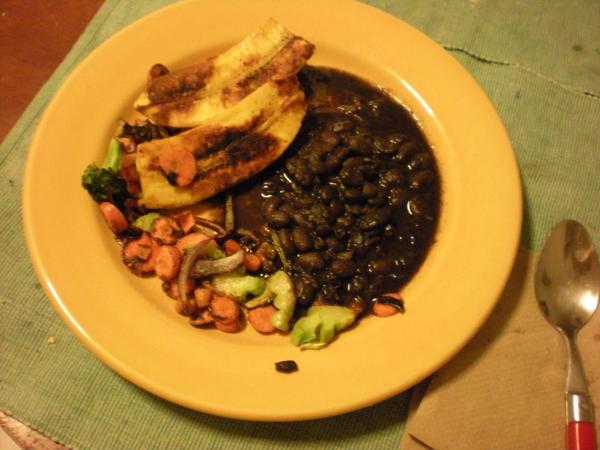UNITED STATES—The people at 1980 Estrella taught me about cooking. Since I knew next to nothing, my culinary skills and variety grew exponentially. The smell of frijoles simmering on the stove became a welcome accompaniment as I put in solid days on my screenplay.
That promising and comforting smell assuaged the staleness that pervaded the elderly house that many transient lives had traipsed through.
Beans became a mainstay. They were the stuff of life. They were what allowed me to survive for what seemed like many weeks on only $10. Because most of us were living as close to the edge as you can live without falling off, as a group we prized grub that was cheap and plentiful. And beans fit the bill.
Jacinto’s expecting wife, Magdalena, showed me how to make frijoles de olla and the young couple from Mexico taught me how to make refried beans. Well in tune with the prevailing love of frying in our shared household, I’d boil the beans all afternoon, and then mash them on a fry pan with oil.
Over time, I was introduced to the delicacy of fried bananas. A dollop of sour cream on top of the browned bananas was the crowning touch. Beans on the side, and boy that was a treat.
The young Mexican couple who lived in the big downstairs room—what had been the dining room when the house was in her first glory—taught me the basics of salsa in a blender. It was a revelation. Where I grew up we didn’t use the blender. It was forbidden; my mom was allergic to cleaning the thing, so the blender remained an ornament in our kitchen. This was a big deal for me branching out into using a blender and making homemade salsa.
To this day Pedro and Taba’s recipe serves. Put a little oil on a fry pan and sear chiles (Serrano or jalapeño) and tomatoes. Keep them moving with a spatula. When the skin blackens hold it under a running faucet and peel off the black patches, then throw the tomatoes and chiles into the blender, along with a handful of chopped onion, pinches of salt, and bits of this fresh herb that smelled of heaven. This fresh herb that smelled of heaven—that was cilantro.
Also Pedro and Taba taught me how to make green salsa with tomatillos, the funny little green tomatoes.
To this day salsa, as I learned to make it at the house, transforms a dish into an experience.
Mac Murphy, the ruddy electrician, who lived upstairs and worked for the owner shared a great breakfast cross-over: fried tortilla and egg. Quick, tasty and nutritious. On a fry pan put some oil (that’s how all the recipes started), tear the corn tortilla into triangle pieces, let them fry till they get golden crisp around the edges. Then break a couple eggs on top. Keep turning with the spatula till the eggs and fried tortilla bits mixed with egg get cooked.
I also credit Mac with introducing me to chorizo, the spicy Mexican sausage that came in a plastic sleeve. That too could be fried and mixed with egg. I think it took me a while to catch on that the red grease that ran off the sizzling meat ought to be drained off. So my versions of the dish were sopping with grease that got soaked up in the accompanying tortilla warmed on the open burner, charcoally on the edges. During that period chorizo was my primary meat, because it was cheap and I could pick it up at the Korean’s store cater-corner.
The house’s newest resident Lawrence Brown added a new smell mix, a peppery condiment, ground red pepper. Since my room opened onto the kitchen I was sensitive to all these changes. Lawrence made pork chops and black-eyed peas and ham hocks—the pig’s pork knuckle. At the time I thought, wow, that’s a big gristly unappetizing hunk of meat.
Lawrence helped me more in the esteem department. He was so dedicated to being on time, ironing his shirt uniform. Just the idea of going out to LAX awoke in me the allure of foreign capitals and tropical beaches, far from our little world on Estrella Avenue and 22nd St. His actions gave me confidence in the changes he was making in his life. Often, before going to the airport, he’d make something in the kitchen. One afternoon I came out of my room.
“How’s the screenplay going, champ?” Lawrence asked.
After a very long pause I came up with an answer.
“I’m thinking about a title—‘Rampage’ or ‘The Persecuted.’”
“What’s it about?”
“It’s about,” I hemmed and hawed. “It’s about, uh, well, high school kids worship Satan and go on a killing spree.”
“That will definitely sell. I like ‘Rampage’ better.”
I didn’t take Lawrence’s title choice, but I took his words as a vote of confidence that I was on the right track. I was a genius. I was soon to be a genius and a rich man.
Looking back now realize I was becoming rich in untold ways, transformed by the people and food culture that surrounded me.
To be continued…
Humorist Grady Miller is the author of “Lighten Up Now: The Grady Diet,” available on Amazon.com. Grady can be reached at grady.miller@canyon-news.com.






